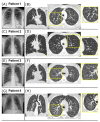Do Not Miss Acute Diffuse Panbronchiolitis for Tree-in-Bud: Case Series of a Rare Lung Disease
- PMID: 35885557
- PMCID: PMC9323848
- DOI: 10.3390/diagnostics12071653
Do Not Miss Acute Diffuse Panbronchiolitis for Tree-in-Bud: Case Series of a Rare Lung Disease
Abstract
Acute bronchiolitis is a common disease of infants affecting the small airways. Rarely, acute bronchiolitis may occur in adolescents and adults. Here, we present four unrelated adolescent patients with severe clinical presentation and unique CT imaging with extensive tree-in-bud pattern, representing a rare clinical phenotype of acute diffuse panbronchiolitis. This characteristic disease pattern caused by inhalation injury from waterpipes, smoked tobacco, and cannabinoids must be differentiated from e-cigarette or vaping product-use-associated lung injury (EVALI). Visual diagnosis of CT and an early diagnostic procedure for detection and differentiation of inhaled hazards, including sample storage for future identification of novel noxious agents, are warranted.
Keywords: acute bronchiolitis; acute diffuse panbronchiolitis; case report; pediatric pulmonology; pulmonology; respiratory failure; tree-in-bud pattern.
Conflict of interest statement
The authors declare no conflict of interest.
Figures



Similar articles
-
CT Findings and Patterns of e-Cigarette or Vaping Product Use-Associated Lung Injury: A Multicenter Cohort of 160 Cases.Chest. 2021 Oct;160(4):1492-1511. doi: 10.1016/j.chest.2021.04.054. Epub 2021 May 3. Chest. 2021. PMID: 33957099 Free PMC article.
-
E-cigarette, or vaping, product use-associated lung injury in adolescents: a review of imaging features.Pediatr Radiol. 2020 Mar;50(3):338-344. doi: 10.1007/s00247-019-04572-5. Epub 2020 Jan 2. Pediatr Radiol. 2020. PMID: 31897566
-
E-cigarette or Vaping product use Associated Lung Injury (EVALI) in a 15 year old female patient - case report.Ital J Pediatr. 2022 Jul 19;48(1):119. doi: 10.1186/s13052-022-01314-6. Ital J Pediatr. 2022. PMID: 35854320 Free PMC article.
-
Recent advances in the understanding of bronchiolitis in adults.F1000Res. 2020 Jun 8;9:F1000 Faculty Rev-568. doi: 10.12688/f1000research.21778.1. eCollection 2020. F1000Res. 2020. PMID: 32551095 Free PMC article. Review.
-
Radiologic, Pathologic, Clinical, and Physiologic Findings of Electronic Cigarette or Vaping Product Use-associated Lung Injury (EVALI): Evolving Knowledge and Remaining Questions.Radiology. 2020 Mar;294(3):491-505. doi: 10.1148/radiol.2020192585. Epub 2020 Jan 28. Radiology. 2020. PMID: 31990264 Review.
References
Grants and funding
LinkOut - more resources
Full Text Sources

